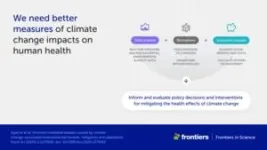(Press-News.org) AMHERST, Mass. – Recent research led by the University of Massachusetts Amherst evaluates how well machine learning can identify different insect species by their sound, from malaria-carrying mosquitoes and grain-hungry weevils to crop-pollinating bees and sap-sucking cicadas. Listening in on the insect world gives us a way to monitor how populations of insects are shifting, and so can tell us about the overall health of the environment. The study, published in the Journal of Applied Ecology, suggests that machine and deep learning are becoming the gold standards for automated bioacoustics modeling, and that ecologists and machine-learning experts can fruitfully work together to develop the technology’s full potential.
“Insects rule the world,” says Laura Figueroa, assistant professor of environmental conservation at UMass Amherst and the paper’s senior author. “Some are disease vectors and pests, while others pollinate nutritious crops and cycle nutrients. They’re the foundation of ecosystems around the world, being food for animals ranging from birds and fishes to bears and humans. Everywhere we look, there are insects, but it’s difficult to get a sense of how their populations are changing.”
Indeed, in the age of chemical pesticides, climate change and other environmental stressors, insect populations are changing drastically. Some species—like the pollinators that are annually responsible for ecosystem services estimated at well over $200 billion worldwide—seem to be crashing, while others, like mosquitoes that can carry malaria, dengue and other diseases, seem to be surging. Yet it can be difficult to get an accurate picture how insect populations are shifting.
Many traditional methods of sampling insect populations involve sending entomologists out into the field to collect and identify individual species, and while these methods can yield reliable results, it’s also time and resource intensive and often lethal to the insects that get caught. This is where AI comes into the picture.
“After working in the field for over a decade, I can tell the difference between a bee’s buzz and a fly’s buzz,” says Figueroa. “Since many, but not all, insects emit sound, we should be able train AI models to identify them by the unique sounds they make.”
In fact, such training is already happening—but which AI methods are best?
To answer this question, Figueroa and her colleagues, including lead author Anna Kohlberg, who completed this research while working in the Figueroa lab, conducted a systematic literature review to analyze studies that used different kinds of automated bioacoustics models to identify insects. They found models for 302 different species spread across nine taxonomic orders. They broke the resulting models down into three broad categories: non-machine learning, machine learning and deep learning.
The non-machine learning models match insect calls to specific markers that human researchers designate as keys for identification, such as a particular frequency band in a katydid’s call. The model then “listens” for those specific, human-designated cues.
Machine learning, on the other hand, has no pre-ordained set of markers that it uses and instead relies on a flexible computational framework to find relevant patterns in the sounds, then matches those patterns to bioacoustics data that it has been trained on.
Deep learning, a specialized kind of machine learning, relies on more advanced neural computational frameworks that give the model more flexibility in effectively identifying relevant bioacoustics patterns. As it turns out, the models relying on deep learning are the most successful. Some of the best can classify hundreds of species with more than 90% accuracy.
“This doesn’t mean that AI can or should replace all traditional monitoring approaches,” says Kohlberg, and there are limitations in what they can do. Most of the models need huge sets of data to train on, and while they are getting better at working with smaller data sets, they remain data-intensive tools. Furthermore, not all insects emit sounds—such as aphids. And very noisy contexts, like an urban environment, can easily confuse sound-based monitoring efforts.
“Automated bioacoustics is a key tool in a multifaceted toolkit that we can use to effectively monitor these important organisms all over the world,” says Kohlberg.
A full media kit containing images and audio is available here.
Contacts: Laura Figueroa, llf44@umass.edu
Daegan Miller, drmiller@umass.edu
END
Researchers at UMass Amherst are listening in on the world’s rulers—insects—to better gauge environmental health
New study identifies best AI method for monitoring insect populations
2024-04-04
ELSE PRESS RELEASES FROM THIS DATE:
Climate change impacts terrorist activity
2024-04-04
Changing weather patterns induced by climate change are contributing to shifts in the location of terrorist activity, according to new research.
An exploratory study led by extremism expert Dr Jared Dmello, from the University of Adelaide’s School of Social Sciences, found some climatological variables affected terrorist activity in India.
“Suitability analyses indicate that all the climatological variables tested – temperature, precipitation, and elevation – relate to shifting patterns of terrorist activity,” says Dr Dmello.
“Urban centres have increasingly grown in population ...
Exercise habits in youth create better health outcomes for some
2024-04-04
Forming a long-term recreational exercise habit as a young person has a beneficial impact on physical and mental health later in life, but some groups, such as females and academic high-achievers, miss out on these benefits disproportionately.
A University of Adelaide study found females, people with low self-efficacy, reluctant exercisers, higher academic achievers, and those experiencing socioeconomic disadvantage are all most at risk of failing to establish regular exercise patterns during the transition from adolescence to young adulthood.
The finding was made by examining data collected as part of the Longitudinal Survey of Australian ...
Researchers uncover a potential method for interrupting the misfolding of tau protein that underlies neurodegenerative disease
2024-04-04
(Santa Barbara, Calif.) — A spectrum of neurodegenerative diseases, including frontotemporal dementia (FTD), progressive supranuclear palsy (PSP) and corticobasal degeneration (CBD) are due to the accumulation of abnormal, misfolded tau proteins in the brain. A team of researchers led by UC Santa Barbara scientists has found potential ways to interrupt this process by targeting “sticky” sites along the long form of mutated tau, preventing the misfolding and spreading of the neurofibrillary tangles.
“This is ...
UT Health San Antonio establishes Be Well Institute on Substance Use and Related Disorders
2024-04-04
SAN ANTONIO, April 3, 2024 – The University of Texas Health Science Center at San Antonio (UT Health San Antonio) is establishing the Be Well Institute on Substance Use and Related Disorders, a pioneering initiative dedicated to advancing research, education and evidence-based treatments.
The new institute includes the current Be Well Texas initiative of UT Health San Antonio as part of a new overall comprehensive center of excellence with national scope for research, clinical and public health programs, as well as education and community engagement to advance the field addressing addiction and related conditions.
The goal of the Be Well Institute is to be a nationally premiere substance ...
Study finds high amounts of silica exposure in previously deployed military veterans
2024-04-04
Since the conflicts that followed 9/11 in 2001, military veterans deployed to areas in Southwest Asia, Iraq, Afghanistan, and the Horn of Africa have been developing respiratory diseases caused by inhaling particulate matter linked to their deployment locations and job duties. New research published in the International Journal of Environmental Research and Public Health shows levels of silica and other silicates are significantly higher in the lungs of those who have had past deployments compared to normal lung tissue.
“Using ...
Life expectancy increased as world addressed major killers including diarrhea, lower respiratory infections, and stroke
2024-04-04
Global life expectancy increased by 6.2 years since 1990 according to a new study published in The Lancet. Over the past three decades, reductions in death from leading killers fueled this progress, including diarrhea and lower respiratory infections, as well as stroke and ischemic heart disease. When the COVID-19 pandemic arrived in 2020, however, it derailed progress in many locations. This is the first study to compare deaths from COVID-19 to deaths from other causes globally.
Despite the challenges presented by the COVID-19 pandemic, the researchers found that the super-region of Southeast Asia, East Asia, and Oceania had the largest net ...
Research shows direct link between state income taxes and migration
2024-04-04
After the introduction of the income tax in the United States, there has been a migration of higher income earners toward states with lower or no income tax, a new study reveals.
This first-ever systematic analysis of 110 years of state income tax implementation throughout the United States also highlights the consequences of taxpayers fleeing to low or no-tax states. Published in the American Economic Journal: Economic Policy, the study is titled “The Introduction of the Income Tax, Fiscal Capacity, and Migration: Evidence from U.S. States” and was coauthored by Ugo Antonio Troiano, economist and associate ...
SynGAP Research Fund (SRF) appoints Kathryn Helde, PhD, as Chief Scientific Officer (CSO) focusing on SYNGAP1 research
2024-04-04
Mill Valley, CA – April 4, 2024 – SynGAP Research Fund 501(c)(3), the leading patient advocacy group working to improve the lives of SYNGAP1-Related Disorder (SRD) patients, today announced the appointment of Kathryn Helde, PhD, as its Chief Scientific Officer, effective February 1, 2024.
“SRF’s scientific grantmaking, industry partnerships, and repurposing efforts have grown past the point where we need a dedicated CSO,” says Mike Graglia, SRF’s Co-Founder and Managing Director. “We are fortunate to have a parent in our ranks who is as well trained, talented, and dedicated as Dr. Helde. As a volunteer for years, ...
Recent contact with young children linked to trebling of risk of over-60s acquiring pneumonia-causing bacteria
2024-04-04
Findings from US longitudinal household study add to ongoing US vaccination policy discussions by suggesting that pneumococcal vaccination in older adults is important even in populations where children are vaccinated at high rates.
**Note: the release below is a special early release from the European Congress of Clinical Microbiology and Infectious Diseases (ECCMID 2024, Barcelona, Spain, 27-30 April). Please credit the congress if you use this story**
New research being presented at this year’s European Congress of Clinical Microbiology and Infectious Diseases (ECCMID 2024) in Barcelona, Spain (27-30 April) finds that pneumonia-causing ...
Dartmouth researchers map how the brain regulates emotions
2024-04-03
Ever want to scream during a particularly bad day, but then manage not to? Thank the human brain and how it regulates emotions, which can be critical for navigating everyday life. As we perceive events unfolding around us, the ability to be flexible and reframe a situation impacts not only how we feel, but also our behavior and decision-making.
In fact, some of the problems associated with mental health relate to individuals' inability to be flexible, such as when persistent negative thoughts make it hard to perceive a situation differently.
To help address such issues, a new Dartmouth-led ...
LAST 30 PRESS RELEASES:
Decoupling the HOR enhancement on PtRu: Dynamically matching interfacial water to reaction coordinates
Sulfur isn’t poisonous when it synergistically acts with phosphine in olefins hydroformylation
URI researchers uncover molecular mechanisms behind speciation in corals
Chitin based carbon aerogel offers a cleaner way to store thermal energy
Tracing hidden sources of nitrate pollution in rapidly changing rural urban landscapes
Viruses on plastic pollution may quietly accelerate the spread of antibiotic resistance
Three UH Rainbow Babies & Children’s faculty elected to prestigious American Pediatric Society
Tunnel resilience models unveiled to aid post-earthquake recovery
Satellite communication systems: the future of 5G/6G connectivity
Space computing power networks: a new frontier for satellite technologies
Experiments advance potential of protein that makes hydrogen sulfide as a therapeutic target for Alzheimer’s disease
Examining private equity’s role in fertility care
Current Molecular Pharmacology achieves a landmark: real-time CiteScore advances to 7.2
Skeletal muscle epigenetic clocks developed using postmortem tissue from an Asian population
Estimating unemployment rates with social media data
Climate policies can backfire by eroding “green” values, study finds
Too much screen time too soon? A*STAR study links infant screen exposure to brain changes and teen anxiety
Global psychiatry mourns Professor Dan Stein, visionary who transformed mental health science across Africa and beyond
KIST develops eco-friendly palladium recovery technology to safeguard resource security
Statins significantly reduce mortality risk for adults with diabetes, regardless of cardiovascular risk
Brain immune cells may drive more damage in females than males with Alzheimer’s
Evidence-based recommendations empower clinicians to manage epilepsy in pregnancy
Fungus turns bark beetles’ defenses against them
There are new antivirals being tested for herpesviruses. Scientists now know how they work
CDI scientist, colleagues author review of global burden of fungus Candida auris
How does stroke influence speech comprehension?
B cells transiently unlock their plasticity, risking lymphoma development
Advanced AI dodel predicts spoken language outcomes in deaf children after cochlear implants
Multimodal imaging-based cerebral blood flow prediction model development in simulated microgravity
Accelerated streaming subgraph matching framework is faster, more robust, and scalable
[Press-News.org] Researchers at UMass Amherst are listening in on the world’s rulers—insects—to better gauge environmental healthNew study identifies best AI method for monitoring insect populations





